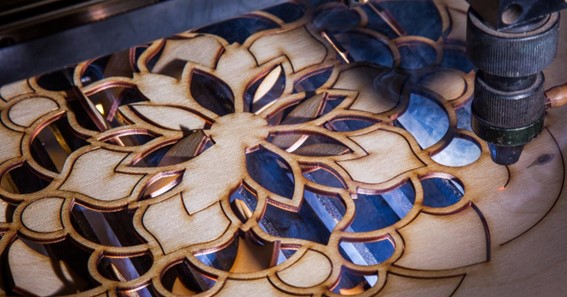With industrial-grade equipment, laser cutters provide accuracy and intricacy that would be easier to attain. These devices can not only cut but also engrave a variety of materials.
Flux provides three laser cutters: Beambox Pro, Beambox Compact, and Beamo, allowing for a wider range of applications. When comparing Beamo to Beambox Pro, each model offers a larger area and more watts (power), enabling faster cutting of larger and thicker items.
Materials
When designing and constructing with a flux emblaser 2 – laser cutter & engraver with air assist, you have a lot of alternatives. Among the many materials that may be engraved or cut are:
- Tile/stone silicone
- Paper
- Leather
- Acrylic
- Wood
- Cardboard
- Glass
- Anodised aluminium
- Fabric
Click here – What To Wear With A Denim Shirt?
User-Friendly Software
Flux laser cutters, with its software known as Beam Studio, may be utilised by beginners to professionals to produce outstanding projects like a master when it comes to managing a laser cutter!
Furthermore, features such as a live camera preview make it easy to use by allowing you to drag and align a picture straight onto an item for ideal placement.
Model Comparison of Every Flux Laser Cutter
Each model of laser cutter differs. Here’s how:
Beamo
It is a versatile 30-watt laser cutter with a tiny footprint. Because of its low price of $1899, this high-powered laser cutter is an ideal starting point for many customers, including enthusiasts, manufacturers, enterprises, and educational institutions.
Beambox Compact
It has a 40-watt laser cutter, which allows it to cut larger materials and do quicker engravings and cuts. The FLUX Beambox CO2 Laser Cutter & Engraver may cut a piece of material up to 15.7″ x 14.7″ in size.
Beambox Pro
The Beambox Pro is the largest, quickest, and most powerful flux laser cutter. It can cut heavy materials, has a 23.6″ x 14.7″ work surface, and can engrave and cut at high rates with its 50-watt laser while preserving exceptional quality and detail.
A CO2 laser is used in flux laser cutters. High accuracy is always the norm when combined with a strong frame.
Click here – THREE BEST INTERNATIONAL CARDS FOR AIRPORT LOUNGE ACCESS AND THEIR FEATURES
Add-Ons, Upgrades, and Accessories
Add-ons, upgrades, and accessories are no exception.
WiFi
Every flux laser cutter comes with a signal antenna for convenient WiFi control. While the laser cutters may also be operated by Ethernet connection, having the choice of WiFi provides far greater accessibility and flexibility.
Rotary Add-On
With the rotational add-on, you can now curve and engrave on surfaces. Because flux laser cutters can engrave on anodised aluminium, stone, and glass, circular things like water glasses, coffee cups, and anodised aluminium reusable water bottles may all be engraved.
Beam Air Fume Extractor
The ideal companion for a laser cutter! Beam Air reduces the particulates and fumes created by the laser-cutting process. The Beam Air also enables laser cutters to be operated inside without needing a hose to the outside. A user may also manage the degree of power on the Beam Air with a knob. The Beam Air is compatible with any flux laser cutter, as well as the majority of other laser cutters.
The 3 Main Types of Lasers
The laser beam is the most important component of the laser engraver; it defines power and wavelength, and hence the material that it can engrave or cut. The following are the three major kinds of lasers used in laser cutting:
-
Solid-State Laser
One of the oldest systems, solid-state lasers, employs a glass or crystalline rod “doped” with ions that produce the needed energy levels. The two most frequent are the Nd:YAG laser and diode laser.
A laser diode is a semiconductor device that, like a light-emitting diode, produces a laser beam at its junction. This method is often used in laser pointers and CD/DVD/Blu-ray disc recording and reading.
In addition, the power of a diode laser is often less than 10W; for example, the laser engraving unit of the FLUX Delta+ employs a 200mW diode laser. Because of their low power, slow engraving pace, and dark hue, diode lasers are suited for limited quantities of nonmetal engraving.
-
Fibre Laser
Fibre lasers are solid-state lasers that are becoming more used in metal cutting. They are powered by semiconductor laser diodes and have a high output power due to the fibre’s high volume-to-surface area ratio, which allows for effective cooling.
The fibre laser is ideal for metal cutting and engraving but not for nonmetal cutting and engraving. Though more expensive, the superior optical speed and quality make this laser an excellent option for commercial metal cutting and marking.
-
CO2 Laser
One of the first gas lasers to be invented was the carbon dioxide laser. In this form of laser, energy is sent through a gas-filled tube to generate light.
40W – 150W CO2 Laser
CO2 lasers range in power from 1000W to 5000W and can also cut metal. This approach is more advanced than others; the results and accuracy are superior to a fibre laser. However, it consumes more power.
1000W+ High Power CO2 Laser
This laser’s wavelength is 10640 nm, which can be absorbed by most organic materials, making it ideal for engraving and cutting nonmetals such as acrylic, paper, leather, wood, rubber, and others. Engraving is possible on glass, pebbles, and anodised metal. Materials with a higher melting point cannot be cut while a 50W machine is running at full power, but if coated with a specific coating, even metals such as stainless steel and titanium may be marked.
Conclusion
Choose the best model depending on your needs if you are searching for the top flux laser cutter on the market. Laser cutters have exceptional characteristics that will enable you to create future masterpieces. Technology has made creating more enjoyable, simple, and revolutionary. It is entirely up to you to incorporate technology into your work and make it your own.

